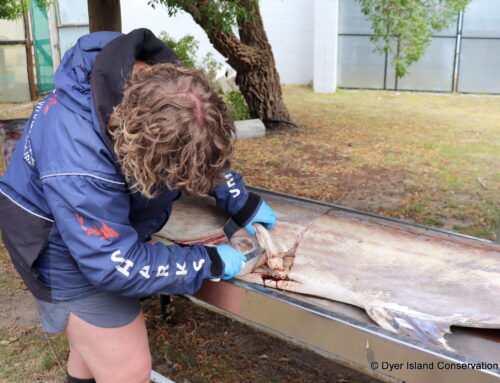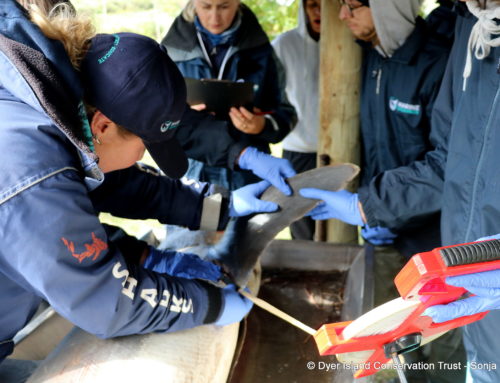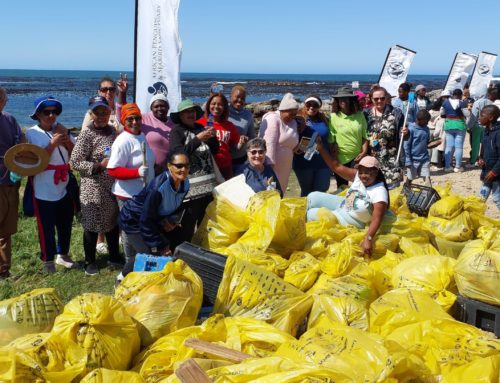Amy shares results of her study
June 26, 2012 by dyertrust
What has been the most unexpected result of your study?
 Three weeks in, I now have over 9 hours of underwater footage of white sharks visiting Slashfin. Some no-sea days due to bad weather have given me the chance to start analysing my footage, which involves extracting stills from the video and cataloging the sharks by keywords. It is important to do this so I do not repeat shark observations by mistake, and I can add notes on parasite presence, sex, and wounding to the photos. I basically stare at hundreds of images of white sharks trying to decipher unique individual markings to use for identification. After a few hours, white and grey markings on sharks all start to look the same, but with sufficient tea breaks my mini-catalogue is taking shape.
Three weeks in, I now have over 9 hours of underwater footage of white sharks visiting Slashfin. Some no-sea days due to bad weather have given me the chance to start analysing my footage, which involves extracting stills from the video and cataloging the sharks by keywords. It is important to do this so I do not repeat shark observations by mistake, and I can add notes on parasite presence, sex, and wounding to the photos. I basically stare at hundreds of images of white sharks trying to decipher unique individual markings to use for identification. After a few hours, white and grey markings on sharks all start to look the same, but with sufficient tea breaks my mini-catalogue is taking shape.
What has surprised me is how many sharks I can see on the underwater footage which our biologists on the boat, and myself at the time, had no idea were present when taking data from the surface. Having worked with white sharks before, I was used to the frustrating aspect of not all of the sharks breaking the water for a nice dorsal fin identification photo, or even coming close enough to confirm they’re a new shark for that day, but fortunately some stunning visibility around Dyer Island and the Geldsteen recently has enabled optimum underwater surveillance. (Video also has that natty advantage of being replayable so you can double-check details to your hearts content!).) The seemingly relaxed behaviour of the sharks aggregating under the boat in such clear conditions was surprising. Perhaps if they are more aware of other individuals in their surroundings they are less easily spooked by one another? Two sharks even clashed heads as they both rush towards the bait line – clearly neither in a cautious mood. In the past 4 years (on and off) working with these animals, I have never seen them so tolerant of one another.
 Another unexpected thing occurred at about 10pm one night as I continued to stare at my still image library before bed (and guaranteeing shark-filled dreams, nothing new there). I matched an individual on June 11th to the same shark on June 3rd, using the grey/white border pattern near the pelvic fin. What was surprising was that this animal on June 3rd had many copepod parasites on its pectoral fins and their egg cases looked like long hairs trailing from the fins. It was very distinctive, but 8 days later they had gone. Now, this isn’t exactly news; we know white shark ectoparasites appear and disappear and don’t stay attached permanently, but for a parasite-focused study it was certainly noteworthy. And again, new questions are raised: did the shark swim into colder or warmer water which may have caused the parasites to drop off? Were they physically dislodged? Or did they release their eggs of their own accord?
Another unexpected thing occurred at about 10pm one night as I continued to stare at my still image library before bed (and guaranteeing shark-filled dreams, nothing new there). I matched an individual on June 11th to the same shark on June 3rd, using the grey/white border pattern near the pelvic fin. What was surprising was that this animal on June 3rd had many copepod parasites on its pectoral fins and their egg cases looked like long hairs trailing from the fins. It was very distinctive, but 8 days later they had gone. Now, this isn’t exactly news; we know white shark ectoparasites appear and disappear and don’t stay attached permanently, but for a parasite-focused study it was certainly noteworthy. And again, new questions are raised: did the shark swim into colder or warmer water which may have caused the parasites to drop off? Were they physically dislodged? Or did they release their eggs of their own accord?
I shall be keeping my eyes peeled for any more novel observations that this project method may unveil. One thing is for sure, the white shark will always have the potential to surprise us.






